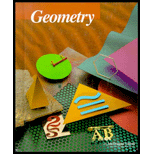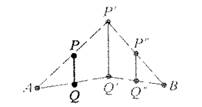
To write: The type of transformation of the composite dilations
Answer to Problem 29WE
The composite of both dilations is a translation.
Explanation of Solution
Given information: The

Calculation:
A transformation related to similarity rather than congruence is called dilation. The dilation
The dilation
(1) If
(2) If
(3) The center
The dilation is called an expansion for
A glide or translation is the movement of a plane from one position to another without changing its orientation, or in simple words, a transformation that glides all points of a plane the same distance in the same direction is called a translation.
Consider dilation about the point
Consider dilation about the point
The first dilation is an example of expansion and it expands the line
It is clear that it composite of both dilations can be written as;
The only difference is the position of the image, and it is not same, so it is a case of translation.
Therefore, the composite of both dilations is a translation.
Chapter 14 Solutions
McDougal Littell Jurgensen Geometry: Student Edition Geometry
Additional Math Textbook Solutions
Basic Business Statistics, Student Value Edition
College Algebra with Modeling & Visualization (5th Edition)
A Problem Solving Approach To Mathematics For Elementary School Teachers (13th Edition)
Elementary Statistics
Algebra and Trigonometry (6th Edition)
- 6arrow_forwardDoor 87.5in to 47 living 44.75 Closet 96in Window ISS.Sin 48in Train Table 96in 48in 132:2 Windowarrow_forward39 Two sides of one triangle are congruent to two sides of a second triangle, and the included angles are supplementary. The area of one triangle is 41. Can the area of the second triangle be found?arrow_forward
 Elementary Geometry For College Students, 7eGeometryISBN:9781337614085Author:Alexander, Daniel C.; Koeberlein, Geralyn M.Publisher:Cengage,
Elementary Geometry For College Students, 7eGeometryISBN:9781337614085Author:Alexander, Daniel C.; Koeberlein, Geralyn M.Publisher:Cengage, Elementary Geometry for College StudentsGeometryISBN:9781285195698Author:Daniel C. Alexander, Geralyn M. KoeberleinPublisher:Cengage Learning
Elementary Geometry for College StudentsGeometryISBN:9781285195698Author:Daniel C. Alexander, Geralyn M. KoeberleinPublisher:Cengage Learning

